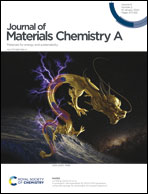Local mobility in electrochemically inactive sodium in hard carbon anodes after the first cycle†
Abstract
Sodium ion batteries are a promising alternative to current lithium ion battery technology, providing relatively high capacity and good cycling stability at low cost. Hard carbons are today the anodes of choice but they suffer from poor rate performance and low initial coulombic efficiency. To improve the understanding of the kinetics of sodium mobility in these materials, muon spin rotation spectroscopy and density functional theory calculations were used to probe the intrinsic diffusion of sodium in a characteristic hard carbon sample. This revealed that atomic diffusion between sites is comparable to that observed in transition metal oxide cathode materials in sodium ion batteries, suggesting that the poor rate performance is not limited by site–site jump diffusion rates. In addition, diffusion was observed in the sodium that is irreversibly stored during the first cycle, suggesting that some of these sodium atoms are not immobilised in the solid electrolyte interface (SEI) layer but are still blocked from long range diffusion, thereby rendering the sodium electrochemically inactive.



 Please wait while we load your content...
Please wait while we load your content...